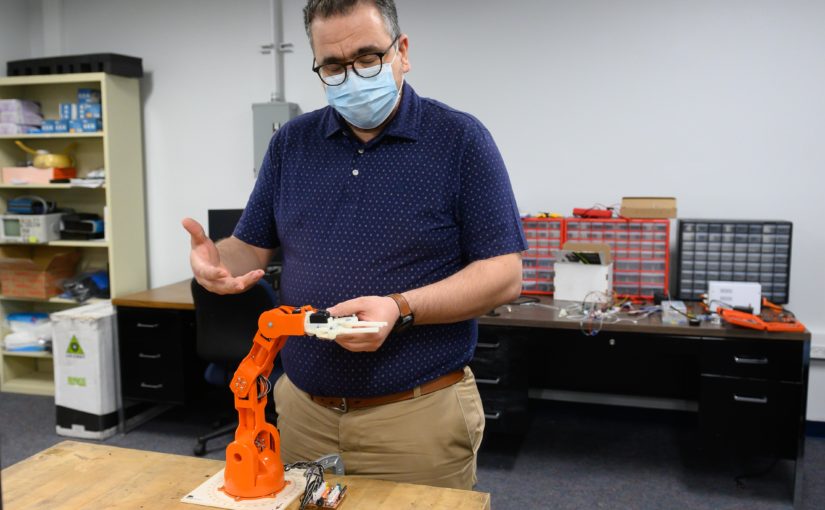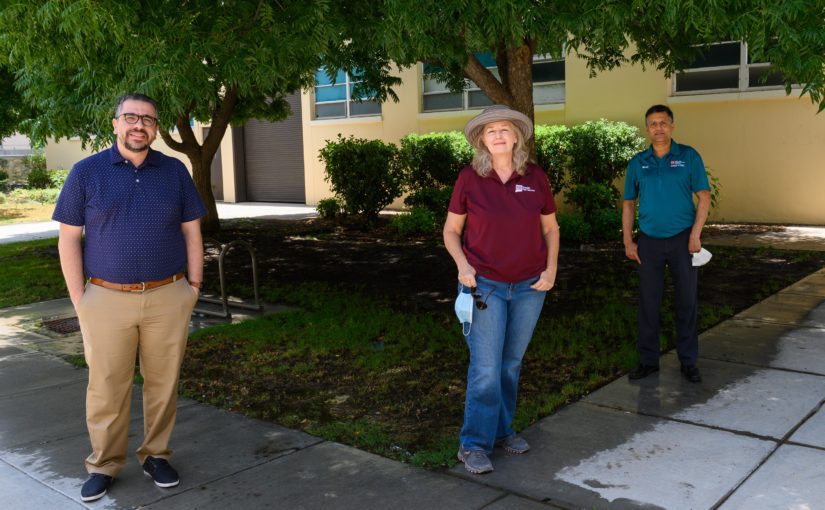Jul 1, 2020Robotic harvesting, data gathering investigated in chile pepper fields
Increasingly scarce irrigation resources and labor availability are key components impacting the sustainability of the New Mexico chile pepper industry.
New Mexico State University’s Center of Excellence in Sustainable Food and Agricultural Systems is providing a grant for the first year of research in the use of mobile robotics to address both of these issues.


“The purpose of the seed grant is to foster multi-departmental and inter-college collaborations and to enhance interdisciplinary research efforts in areas relevant to sustainable food and agricultural systems,” said Natalie Goldberg, director of the center. “This proposed research is a good example.”
The College of Agricultural, Consumer and Environmental Sciences and the College of Engineering are joining forces to determine if green chile peppers can be harvested using a mobile robotic manipulator to replicate hand harvesting. The researchers will also use robotics to evaluate drought stress on the chile plant.
Mechanized harvest
“This is exciting research,” said Stephanie Walker, NMSU vegetable specialist. “Robotic harvest could address both harvesting and pedicel removal, commonly known as destemming, at the same time.”
Over the last 12 years, a breeding line has been developed by Walker for mechanization efficiency. The new breeding lines incorporate traits including reduced force needed to remove the pods from plants, and more complete pedicel removal from the fruit.
“Despite these genetic advances, when these lines are harvested with a double-helix picking machine, the vast majority of marketable fruit harvested keep their stem intact,” Walker said. “Over the years we have not been able to resolve the de-stemming issue.”
Hand harvest is still the best for removing the entire pedicel including the full stem and calyx from the chile pod while picking it from the plant.
“The use of a robotic system, with controlled motion and force to replicate hand harvesting, could be a potential solution to propel mechanization of New Mexico-type green chile,” said Mahdi Haghshenas-Jaryani, assistant professor in mechanical and aerospace engineering, who has worked in robotics for many years but never in the agricultural setting.
Haghshenas-Jaryani will be dealing with several issues while programing the mobile robot and the attached robotic arm, including mobility in a field environment, identification of the ripe chile pod and the amount of force required to pick the fruit without damaging it.
“Robotics is being used to pick other types of produce, but usually in a greenhouse setting, not in a field,” he said. “Secondly, in other applications the fruit is of a different color than the plant, not so with green chile peppers. Third, we do not have quantitated data regarding the force required to pick the chile pepper.”
Drought stress on plants
Many chile farmers rely on past field history to determine when to water their fields. Instrumentation to gauge plant stress is seldom utilized.
“Advanced technologies that have benefited other crops have not yet been explored for chile pepper production,” said Manoj Shukla, professor in plant and environmental science. “This project seeks to embrace one of these technologies – sensor-equipped mobile robots – to provide real time data on actual plant and soil status in the fields.”


The study will investigate water use efficiency of the chile plants being watered with a gravity micro irrigation system The information will allow for informed decisions regarding timing and quantity of irrigation watering.
“Data-driven field management decisions will allow for increased water use efficiency and irrigated water saving; more efficient, higher yielding plants; and allow producers in the state to better respond to erratic climatic conditions experienced more frequently due to climate change pressures,” Shukla said.
To investigate the impact of drought stress on chile plants, the mobile robot can be equipped with sensors to determine the soil moisture, the air temperature under the plant’s canopy and between the rows, and wind velocity. There will also be a camera to visually record the condition of the plant.
“This labor-intensive task of vast data collection on farm can be efficiently carried out using ground robots,” Shukla said. “Robotic systems have been steadily integrated in the agriculture and farming systems to address challenges and problems, such as water scarcity, soil salinization and increasing need to monitor crop health for yield production. This is the first time this technology is being investigated for New Mexico-type green chile production.”














